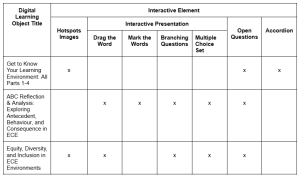The following table identifies what types of interactive element activities are present in each of the digital learning objects, and what those interactions involve.

Accordion: a drop down box which users click on to make content appear, such as questions and additional details. This interactive element mitigates some of the feelings of being overwhelmed at the sight of large amounts of text and information visible on the screen all at once.
Branching questions: a form of multiple choice-style questions which require the user to use their critical thinking and decision making skills to decide which path to take. Making decisions advances the scenarios and can lead to alternative paths, questions, prompts, and/or engagements.
Column: a tool which allows the creator to combine different types of H5P elements (such as text, images, hotspots, and other interactives) in one place using a vertical layout.
Drag the Word: a combination of a fill-in-the-blank and a drag-and-drop activity, but without the possibility of misspelling the word and receiving a false incorrect. Users are presented with the scenario where we can see the blank spaces are left for the missing terms, and along the right side are rectangles with the words to choose from. Users click on and drag their word of choice to a blank space, and can then click the button to check their answers.
Hotspot images: images that have multiple buttons embedded in them. When clicked on, these buttons can provide any combination of additional information, close-up looks at the details in the image, questions, prompts, alternative text, and more.
Mark the words: users click on words to highlight them. The aim of this type of activity is to use critical thinking skills to identify which terms meet the criteria specified in the activity explanation.
Multiple choice set: a multiple choice question or questions which have more than one correct answer.
Open questions: open-ended reflective questions written in text format. This is a prompt which causes internal interactions through thought-provoking open-ended questions, rather than an element requiring a digital response to be entered.

